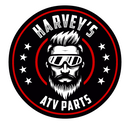CVT Engines in ATVs and 4 Wheelers

CVT ENGINES IN ATVS & 4 WHEELERS
Many of humanity’s coolest contraptions use simple physics to perform their tasks. The transmission of your ATV or UTV is no different. One of the most common transmission types in these vehicles is the continuously variable transmission, or CVT.
When you step on the gas, your CVT balances the rotations per minute (RPMs) of your engine with the RPMs of your input shaft, transmitting the power and acceleration to the wheels. This streamlined system allows your ride to work harder in a variety of conditions while shifting seamlessly.
If you’ve ever wondered what’s going on under the lid of your Polaris’s transmission, this article is for you. Harvey is here to explain the ins, outs, unders, and overs of your ATV and 4-wheeler CTVs.
CVT (Continuously Variable Transmission) Overview
The CVT is made up of three major parts: the primary clutch, drive belt, and secondary clutch.
The primary “drive” clutch is attached to the engine’s output shaft (PTO shaft), and the secondary “driven” clutch mounts to the rear transmission shaft. The drive belt rides between a pair of weighted sheaves on each clutch.

As the engine accelerates, the sheaves of the primary clutch narrow and engage the belt. In response, the secondary clutch widens to give way, creating a higher gear ratio. As such, the CVT can be seen as having a highest and lowest “gear,” with an infinite number of smaller ratios between. So instead of the pop-and-catch feeling that comes with changing from a larger to a smaller gear on your bicycle, shifting through to full throttle on a CVT is a smooth transmission.
The Primary Clutch

Belt

The Secondary Clutch

THE BOTTOM LINE
Stay Tuned
To join our mailing list and never miss the latest ATV tips, tricks, and discounts!

